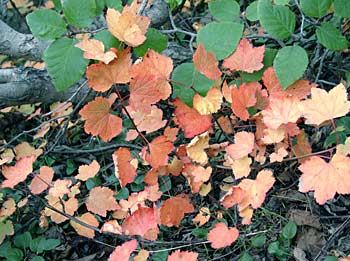Relatives
Ribes procumbens Pall. - Recumbent currant or mokhovka.
Taxonomic position.
Family Grossulariaceae Hill; genus Ribes L.Morphology and biology.
Perennial plant. Prostrate shrub with rooting decumbent and rising shoots, 20-25 cm tall. Stalks are golden, glossy, sparsely dotted with glandules. Leaf blade is up to 4 cm long and 5 cm wide, round or kidney-shaped, with a heart-shaped base and 3-5 mildly expressed round or slightly acutate lobes; bare, dark green above and of lighter color below, dotted with scattered glandules. Petioles are up to 5 cm long. Raceme is 3.5-4 cm long. Rachis and flowers are thin, with sparse, dotty glandules. Flowers are up to 4 mm long. Hypanthium is greenish, with white, curly pubescence and dotty glandules. Flowers are up to 6 mm in length and 6 mm in diameter. Calyx lobes have elongated ovoid shape; they are purple, up to 4.5 mm long and 3 mm wide, densely covered on both sides by white pubescence, sparsely dotted by glandules. Sepals are up to 2 mm long and 1.5 mm wide, bare, purple. Styles are up to 2 mm long, coalesced almost to the top. Ovary is semi-inferior, 2 mm long and 2 mm wide, sparsely dotted with glandules. Berries are up to 1 cm in diameter, dark brown, smooth, dotted with glandules, very fragrant, edible. Blossoms in June; bears fruit in July/August. Entomophilous. Zoochore.Distribution.
Occurs throughout Mongolia, Japan, China and North Korea. Within the former USSR, the species occurs in the southeastern part of Western Siberia, the southern part of Eastern Siberia, and the Far East.Ecology.
Occurs on well-drained sites with moistened soil, near brooks and springs, and in damp forests on stony ground covered by mosses.Utilization and economic value.
Distinguished for its exceptional flavor. Widely used by local populations to make jams, fruit liqueurs and other products. Sometimes is grown (cultivated) by residents in household orchards. Deserves wider domestication and involvement in breeding practices.References:
Harkevich S.S., ed. 1988. Vascular plants of the Soviet Far East. Vol. 3. Leningrad: Nauka, p. 127.Komarov V.L., ed. 1939. Flora of the USSR. Vol. IX. Moscow/Leningrad, Publishing House of the USSR Academy of Sciences, p. 254-255 (in Russian).
Koropachinsky I.Yu., Vstovskata T.N. 2002. Woody plants of Asiatic Russia. Grossulariaceae DC. Novosibirsk: Siberian Division of the Russian Academy of Science, GEO Branch Publishers, p. 266-293 (in Russian).
Malyshev L.I., Peshkova G.A., eds. 1994. Flora of Siberia. In 14 volumes. Volume 7. Berberidaceae-Grossulariaceae. Novosibirsk: Nauka, p. 296 (in Russian).
Poyarkova, A.I. 1936. Critical review of wild currant and gooseberry species in the Soviet Union. Flora and taxonomy of higher plants. Works of the Botanical Institute, USSR Academy of Sciences, series 1, issue 2, p. 153-216 (in Russian).
Shmidt V.M., ed. 1990. Areas of medicinal and related it plants of the USSR. Atlas. Leningrad: LGU, p. 167 (in Russian).


